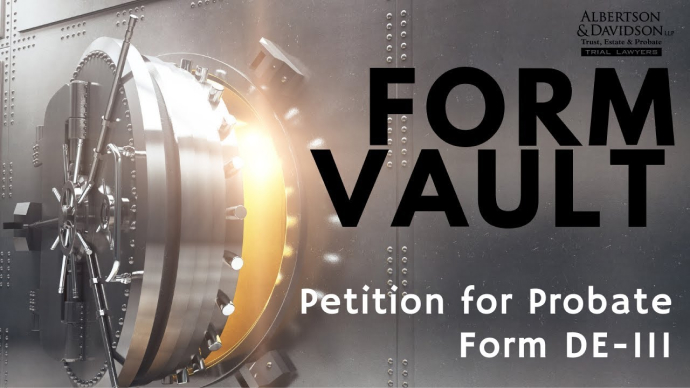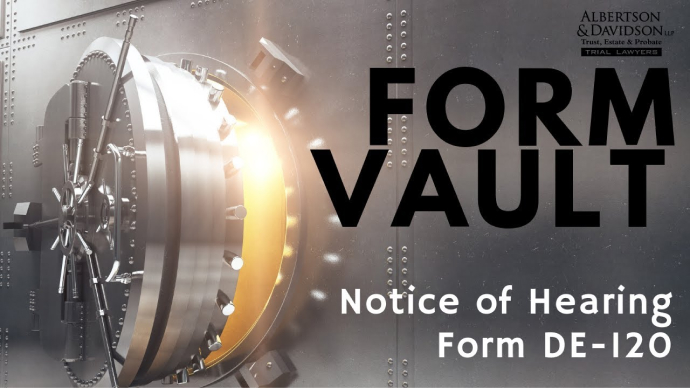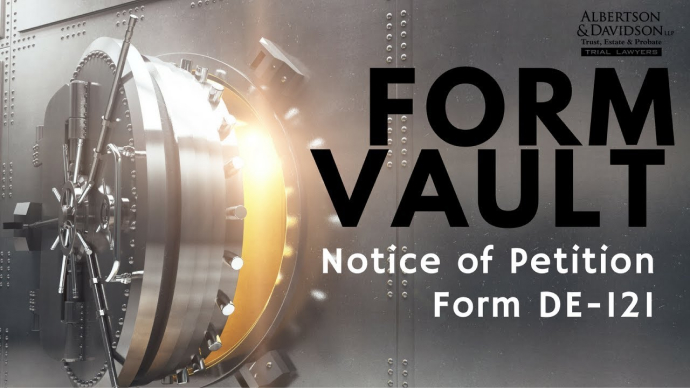Transcript
California will and estate litigation attorney Keith Davidson of the law firm Albertson & Davidson has created a video providing an overview of how to navigate the California Probate Code and pursue a lawsuit against a party who has died. The California Probate Code has specific technical requirements that you have to meet if you want to continue a lawsuit against a deceased person or if you need to file a lawsuit against a deceased individual.
The topics covered in the video include the statute of limitations that applies to all deceased persons, the difference between claims already in litigation vs. unfiled lawsuits, and the claim filing procedures. With the guidance of a knowledgeable California probate lawyer, you may still have a path to pursue legal action against an individual who has died. The attorneys at Albertson & Davidson LLP can review your specific questions and discuss the best approach to pursue a claim after the death of a plaintiff or defendant.
General Statute of Limitations
First, we’re going to talk about a general statute of limitations that applies to all decedents in California.
As a general rule, once an individual dies, all causes of legal action against him or her will expire within one year of their date of death. The California Code of Civil Procedure section 366.2 states that no matter what the statute of limitations may have been on your claim before the person died, your claim will expire one year after the decedent’s death unless you take certain steps in California Probate Court to preserve your claim.
The one-year expiration on claims against the deceased does not apply if you have filed a creditor’s claim against the deceased person’s estate. That is an important step to take. Whether you have a claim that has already been filed or has yet to be filed, ultimately, you are going to have to file a creditor’s claim in the decedent’s estate in Probate Court.
What You Need to Do to File a Creditor’s Claim
Remember, once somebody dies, then they can no longer be a party to a lawsuit. The only person who could then be a party to a lawsuit is the decedent’s personal representative. The good news is that once you file a creditor’s claim in the deceased person’s estate, it is going to toll the statute of limitations until the claim is rejected by the personal representative of the estate.
You can file the claim and the personal representative of the estate, also known as the executor, can choose to accept your claim and pay you the money that you are owed. Alternately, the executor can reject your claim. In that case, you will have to proceed with your lawsuit.
The executor can also accept your claim in part and reject it in part. In this case, you will have to file a lawsuit if you wish to challenge the executor’s decision.
Your Rights as a Potential Creditor of the Deceased
A lot of times, people are unsure whether the defendant has a probate estate.
As a potential creditor, you have a right to file a petition to open probate for any deceased person. If a defendant dies, you can open their probate estate by filing a petition for probate as a creditor.
Typically, what will happen after you file a petition for probate is the deceased person’s family will come in and file a competing petition for probate because they have a will, or they want to be the ones who are executor. Once somebody else comes forward to file a petition for probate for that decedent, then you can let yours go. All you want is for probate to be opened so you can file a creditor’s claim. Once the probate has been filed, you can file your claim and preserve your rights.
We have a separate series of videos on how to fill out a petition for probate, so we’ll link to that video here. You can see a link to the description below. We also have a separate video on how to fill out a creditor’s claim. You can see that as well.
Deadline for Filing a Lawsuit After a Claim is Rejected
Once your creditor’s claim has been rejected by the personal representative, then you have to file your lawsuit. If the personal representative refuses to give you a rejection after 30 days, you can deem that it is rejected and file your lawsuit.
If the claim is rejected and if the claim is due at the time notice is given, meaning this is a ripe lawsuit that you are going to file, then you have to file that lawsuit 90 days after notice is given of the rejection. If you don’t do that, then you’ll be forever barred from filing your lawsuit. Therefore, it’s very important that you pay attention to when your claim is rejected because there are very strict guidelines as to when you have to file your lawsuit after that point in time.
When you do file your lawsuit, make sure you name the personal representative as the party that you are suing in place of the decedent. For example, if Bob Jones is the executor for the Estate of Linda Jones, then you are going to list the party as Bob Jones, Personal Representative for the Estate of Linda Jones. Don’t make the mistake of just naming the Estate of Linda Jones, without naming the personal representative. Estates only act through their fiduciaries, through their personal representatives. If you don’t name the personal representative, then you don’t have a claim that can ultimately be paid on and be valid if it ever goes to judgment. If you go to judgment and you win, then you’re not going to be able to collect if you didn’t name the personal representative.
To recap, if you haven’t filed your lawsuit yet and you need to file and the defendant has died, the first thing that you must do is either open a probate for that defendant, or see if somebody else has opened a probate for that defendant.
Once the probate petition has been filed, then you need to file your creditor’s claim as quickly as you can so you can be sure to preserve your claim. Once your claim has been filed, you have 30 days to wait for it to be deemed to be rejected, or if the personal representative actually rejects your claim before 30 days, then you’ve got 90 days to file your lawsuit.
Once you go through those steps, then you file a lawsuit naming the personal representative as the party to the lawsuit and you’ll proceed just as if the decedent were still alive.
Situations in Which a Lawsuit is Pending
The Probate Code has a separate section for that situation. When an action is already pending at the time of the decedent’s death, then this is what you need to do. First of all, you have to file a claim in that person’s probate estate. The claim is then rejected in whole or in part or you deem it rejected after 30 days.
You as a plaintiff must apply to the court where your civil lawsuit is pending and ask to substitute the personal representative in the action in place of the decedent. Notice 9370 B specifically says that no recovery shall be allowed in the action against property in the decedent’s estate unless proof is made of compliance with this section. That means you have to show that you did these things:
• Filed your creditor’s claim
• After the claim was rejected, you substituted in the personal representative as a party to the lawsuit.
If you failed to do any of those things, you are never going to be able to collect from the decedent’s estate.
Let’s say the decedent has all his or her assets in a trust rather than in a probate estate. Can you still get to those assets? The answer is yes. When you file a claim against a probate estate, if the estate does not have sufficient assets to pay for your judgment, then you can collect against any revocable trust that was created by the decedent during his or her lifetime.
That means if the decedent had $20 million in the trust but zero dollars in the probate estate, once you establish your claim and you’ve done the right procedure in probate court, that claim will then be collectable against the decedent’s trust where the $20 million is held, even though their probate estate has nothing.
Now that we’ve talked about the steps that you have to go through in order to preserve your claim against the decedent, we can switch over to Probate Code 9150. These are the procedures for filing a claim. These procedures are quite easy, and we’ve made a video on how to file a creditor’s claim. The creditor’s claim is so important because until you file that, the clock is ticking. Once you file the creditor’s claim, your statute of limitations is tolled until the claim is rejected or you can deem it rejected after 30 days. You can proceed with your lawsuit or file your suit if it hasn’t already been filed or substitute in the personal representative for your suit that is already pending.
Contact Trust and Will Litigation Law Firm
The California Probate Code is complicated and technical. As experienced trust and will litigation lawyers, Keith Davidson and Stewart Albertson focus on providing clear explanations of the law to help our clients understand their options and fighting aggressively for clients in litigation over probate matters, California trusts or wrongful death. Please contact us to discuss your specific questions.




